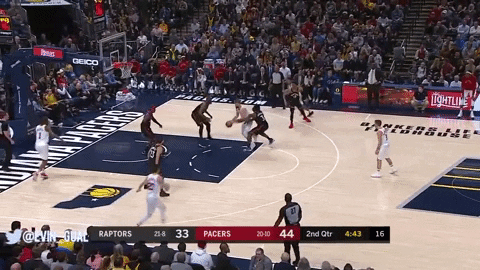The post-up is the most intimate event on a basketball court.
At no other moment are players closer together for a longer period of time. The offensive player has the defender on his back, likely with several points of contact. Arm or shoulder on back, hips, feet: there are more bonds of connection than usually happens in the NBA.
And the post-up is not constituted by an explosion of violence, at least not right away. Other intimate moments, like the in-air collision above the rim, or the bone-crunching screen, involve brief contact defined by force and immediacy. Think Bam Adebayo’s game-saving block on Jayson Tatum: sickening force, enough to make a normal human shatter into a hundred quivering pieces.
The post-up is not that. It’s quieter, slower. Opponents feel each other with enough time for sweat to form and fall before anything substantive seems to happens.
Yet substance is happening at all times. The wheels are churning from the beginning. Derided as a thing from the past, as obsolete, the post-up remains both an integral moment for a spectator, as well as a definitive for the outcome of the game. It’s not anti-modern as much as a foundational element of what makes the modern game itself.
Put another way, the post-up still matters. Desperately. Both as a scoring tool and to initiate an offense. It’s essential for watching and winning in the NBA.
The week in Minute Basketball: The post-up.
Zatzman - Scoring
The post-up lives as the last true challenger standing in the way of homogeneity in the NBA. Not specific homogeneity, as difference will always outnumber sameness at the level of detail. But in the general sense, the pick and roll has taken over the NBA like the Anglo-Saxons in Britain.
It is now, after James Harden has left Houston, the most popular playtype among 30 of 30 NBA teams. That’s been true for quite some time, of course, but the post-up remains a bastion. (So too does isolation offense remain a theme du jour in Oklahoma City.) As recently as 2015-16, six teams attempted double-digit shots out of the post across the league. Now only the Philadelphia 76ers and Los Angeles Lakers remain above that threshold, after just the Sixers reached it last season.
But you know what? The post-up is coming back, albeit less frequently. In 2015-16, 16 players attempted four or more shots out of the post per game. This year, it’s only nine. Yet post scoring at the elite level has never been better. In 2015-16, among the top 20 players in post attempts per game, only one player managed an efficiency of 1.0 point per possession or higher. The next season it was two. Back to one in 17-18. It exploded to six the following year, three in 19-20, and now sits at eight (!) of the top 20 this season (with four more averaging 0.96 or above). That’s right. As offense has become more efficient in the NBA, so too has post scoring. Let’s dive into that relationship.
The 76ers and Lakers are so high on the low post because both teams have multiple elite practitioners. Of course, Joel Embiid and Anthony Davis are the high-profile explorers in that regard, ranking first and seventh respectively in attempts per game. But so too do Tobias Harris, Ben Simmons, and LeBron James attempt multiple post-ups per game. It’s clear that using the post is a systemic approach for those teams, rather than simply a reflection of the physical dominance of each team’s center.
Embiid and Davis do form the bedrock of post scoring in the league today, though. Embiid’s 1.08 points scored per post possession and Davis’ 1.04 points both represent elite numbers, either when compared to other post scorers or to NBA offense in general. Among players who attempt 2.0 post-ups or more per game, both are in the top five for efficiency leaguewide. Those are equivalent to Chris Paul shooting off the catch, for Embiid, or Nikola Vucevic, for Davis.
Translation: the post-up is still an extremely viable scoring play if you have the right guys. Like Embiid or Davis. Also: Simmons and James are even more efficient post scorers than their big-men counterparts, albeit on lower frequencies. Post scoring is no longer a late-clock bailout. It’s now -- and was before! -- a feasible way to initiate good offense at the beginning of an NBA shot-clock.
The best post scorers have bags as deep as Chris Kringle. There are options at every turn, counters to counters to counters like the whole thing is some lost sequel to Pirates of the Carribean.
At times, offensive players don’t need tricks as much as the threat of those tricks. They get exactly where they’re going through sheer uniqueness of their games, their bodies, their skillsets. Here Davis leverages his every nook and cranny like a slinky. He digs the endless angles of his form into crevices to create a lever, forcing his defender to sink with him. He dribbles, dribbles, waiting, with the world expecting a spin or drive or … something. And the whole plot is just to unfurl at the end and loft a jumper over a helpless defender. It was all a magician’s flourish, a distraction.
Pascal Siakam lures defenders to moments of rest by pausing like the Beatles before the crescendo of A Day in the Life. You know something’s coming, and it’ll be big, but you don’t know quite when the storm’s gonna make landfall. Then when the defender’s expecting the uppercut, hit him with the quick jab (step) and have him beat.
That element of surprise doesn’t just have to happen at the beginning of a move. Zion Williamson is expert at shocking opponents by making midair choices that shouldn’t be available to him given his momentum. When opponents expect him to drive middle, he twists baseline. When opponents expect a reverse, he launches himself backwards and goes up on the short side. All the while, he maintains perfect balance, of course.
It can get much more complicated when players string together moves like they’re button mashing. Post scorers can face up, toss in a few jab steps, a few crossovers, finally spin middle, before pump-faking into an up and under. If that’s a mouthful for me to say, think about how much of a stunner it must be to defend.
Or it can be simple: be bigger than the other guy.
Sometimes, the post can be devastating. One wrong move as a defender -- say, you shade baseline and help doesn’t arrive fast enough -- and the best post scorers are sharks at a feeding frenzy. They can smell a weakness and turn it not just into points but into abject humiliation.
It’s a quiet secret in the NBA that the most efficient post-up scorers in the league are no longer centers. Sure, leviathans like Embiid and Davis are the highest frequency scorers from the post, but no longer do centers have the highest points per possession down on the block. There are plenty of guards or wings with more efficient post-up games than Embiid or Davis. Gordon Hayward, Kevin Durant, Devin Booker, DeMar DeRozan, Bradley Beal, Kyrie Irving: all average higher points per possession in the post than Embiid. In fact, among players who average two or more attempts a game, the NBA’s current post-up king is Kawhi Leonard.
Leonard seems to possess a combination of all the skills required for strong post play. He has the strength of a center, able to seal and hold all but the biggest players in the league on his back and hips. He has the first step to face up and zoom past defenders, and the second step to rise up and yam on help. He has fakes galore and the patience to outwait Georgy Zhukov at Leningrad. Plus, he has the touch to hit fading away to either side, off balance, with either hand, from any release point. When he puts it all together, it’s as much art as a Steph Curry triple, a Kyrie crossover, or a LeBron chasedown block.
And, it’s as much a contribution to winning. And yet (and yet!) scoring out of the post is not even the real threat of the play. The true reason why the post-up remains not a thorn in the side of the modern NBA, but in fact a definitive aspect of it, is because of post passing.
I cede the floor to you, Samson.
Folk - Passing
It seems we’ve found the real danger.
There have been formulaic teams in the NBA who have coasted to great regular season records on the back of heavy pick n’ roll possessions, lots of transition, drop defense etc. Dependable, regular season basketball. Those formulaic teams have traditionally had a tougher time translating all of their success to the postseason, because all of the quirks and rhythms change. Nothing comes as easy. A lazy Iverson cut in the regular season becomes a wrestling match at the elbow on both sides in the playoffs. Versatility isn’t the end all be all in the playoffs, but it’s really important.
The ability to invert a defense by playmaking from the post instead of the traditional above the break/downhill version of playmaking, is underrated league-wide. Doubling the ball requires different routes to defensive positioning, and the closer proximity to the rim gives defenders less reaction time to defend tight window passes to bucket-bound cutters. Marc Gasol helped add a different element to the championship Raptors. Split-action was packaged into the trade and delivered to the Raptors offense along with him. Pascal Siakam adds that element to the Raptors today, and when Nate Bjorkgren left his position as assistant coach on the Raptors to become the bench boss in Indiana, he took a lot of the plays the Raptors ran for Siakam, and repurposed them for Domantas Sabonis.
You’ll see a lot of similar actions run for many of the great post-passers in the NBA, but there’s still such a unique flair to each action, because post-passing is all about interpretation. Sometimes the baseline interpretations can be enough. If Joel Embiid gets doubled from the weak-side and the farthest man runs the gambit of the weak-side zone, Embiid has to find a way to make him commit and punish that decision. If he can’t do that, he can simply pass the ball out to the strong side, and the defense might be able to recover.
With players like Nikola Jokic or Domantas Sabonis, there’s always a game of cat and mouse going on. Their primary defender is there, sure, and they feel all the points of contact that Louis brought up, but they hate (hate!) giving the ball up to the strong-side - where is the advantage in that? There’s a constant push and pull, a manipulation of the defense trying to corner them, and they tease help-side players into positions where they can dissect them with their passing. Sabonis is a notch below Jokic, to be sure, but they’re both phenomenal. Two of the only big men who have the patience to let a baseline cut come all the way across the back of the basket.
Sabonis and the brass over at the Pacers organization know just how important the pass out of the post is. If I’m picking up that Sabonis is generating more efficient looks out of the post as a passer than a scorer, they most certainly are. And the thing I love most about post-ups is that the line between physical and competitive post-defense and thorough domination by the offensive player is really thin! You’re so close to the basket, that if a foot slides a couple inches too far, you’re not anchored properly and suddenly Embiid (for example) has wriggled his shoulder past yours and is pulling you away from the basket with his firmly lodged elbow in your side, as he coasts towards it. When teams send help too late, it’s just that - too late. When they send it too early, they’re bending their defense out of shape when the play wasn’t necessarily dangerous yet. Very few teams know how to navigate these situations with finesse.
Teams usually improve defending certain actions the more often they defend them. Closeouts to the 3-point line are as practiced as ever. The pace and clinical footwork/hand extension would look out of place in a lot of other eras, but it fits like a glove in today’s game. The fact that the post is rarely at the forefront of what defenses expect to be bludgeoned with, leaves defenses out of practice.
The post is the least cramped it’s ever been, and the forces that reside there are as talented as any era. The interpretation of what the newly found space should turn into makes the interplay of the post one of the truly underrated and beautiful aspects of basketball. As Louis noted, the right guys (Embiid, and Davis for example) see that space as a vacuum for themselves. Teammates walk along the 3-point line, forming up and maintaining the passing angle to provide help. Don’t cramp the space, ever. Wide windows to pass into, and a lot of space to smash into. These massive gravity post-dominators give life to spot-up shooters who can navigate a shifting defense to find jumpers.
Players like Sabonis and Jokic see space and often think the vacuum exists for others. Teammates don’t necessarily have to form up on the 3-point line, because if you come into the space they operate in, it could create the friction that sets them loose on a basket cut. An audible of a DHO could progress into an overhead lob pass that leads them directly to the hoop. The defender loses the step because Jokic and Sabonis are comfortable in the tight spaces - in fact they thrive in them. These wonderful tight-window, post-operators give life to players who don’t shoot that well, if they have a good nose for a cut. They dictate the inverse of a heliocentric perimeter player, in that it’s far less important to be efficient from your stationed spot, and far more important to indulge in well timed movement.
For the select few players who dominate the post with massive frequency as scorers, well done, you’re extremely tough to emulate and tougher to stop. But post passing is accessible to players who exhibit control and awareness, which happen to come along a bit more often than unbelievably talented behemoths like Embiid, and they reward teams who move intelligently off-ball. Not everyone can bully their way to the bucket, but every year (this years Thad Young for example) more people figure out how to outfox a defense from the post.
The post, in two words: Hell yeah.






















Share this post